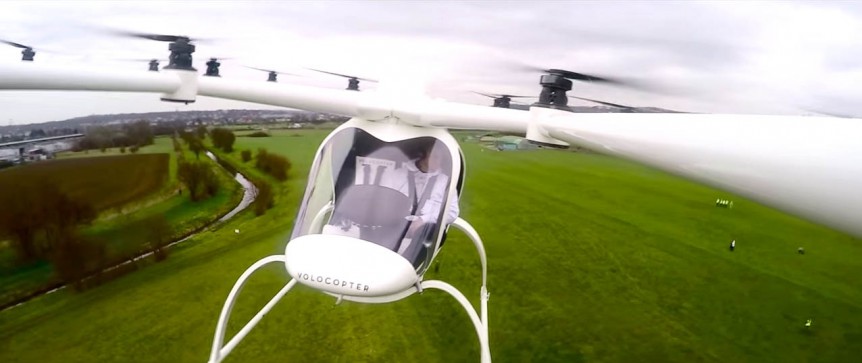e-volo’s Volocopter VC200 made its first “manned” flight on March 30, 2016, with managing director Alexander Zosel maintaining control for a few minutes, and then letting the 18-rotor vehicle find its own way. He held both hands out the side door for several seconds to show the Volocopter was flying itself – and quite stably in hover at that. He repeated the hands-off approach later in the flight.
Zosel lightly held the single control stick in the machine, controlling vertical motion through thumb movement on the video-game-type controller, lateral motion by twisting the control stick, and banking by tilting the control stick. It all seems intuitive and well harmonized. The videos show the flight and its happy aftermath.
Unlike conventional helicopters that require both hands and both feet on the controls, usually in subtle motions that resemble Ringo Starr or Buddy Rich at their best, the single control stick in the VC200 is, according to all concerned, pretty intuitive.
How long will it be before an “Intel Inside” decal appears on the Volocopter’s flanks? German drone maker Ascending Technologies developed “technology assistance” for the multicopter. Intel Corporation recently acquired Ascending Technologies, which makes Intel Capital a direct shareholder in e-volo through that shareholding position.
Josh Walden, senior vice president and general manager of Intel’s New Technology Group, sees a future in this arrangement. “Intel congratulates e-volo on this accomplishment. Technology developed by Ascending Technologies assists in the flight controls, motor electronics and key elements that extend multi-rotor UAV technology to this new type of aircraft. We look forward to aiding the development of more manned and unmanned vehicles in the future.”
The next two years should be exciting for e-volo, with a push to obtain type certification and produce the Volocopter in large quantities. The company hopes to enter “the well-established air sports market,” and then establish air taxi services, initially flying predetermined routes as airport shuttles, or picking up passengers at “sensible traffic nodes.” e-volo sees future public and individual transport in their little machine, perhaps an Uber of the skies.
NASA invited Florian Reuter, the team’s Managing Director of Strategy & Finance to present at a recent “On-Demand Mobility” workshop in Washington, D. C. This, coupled with a discussion of how to develop a legal framework that would allow individual flights in urban areas for everyone, complemented a NASA study which highlights the “positive contribution such a system would have on the alleviation of the daily traffic congestion in the Silicon Valley region in California.”
We’ll check back as flight tests continue on this promising design. e-volo has accomplished a great deal since the first landing on a Pilates ball four years ago. The next four years should be very exciting.

